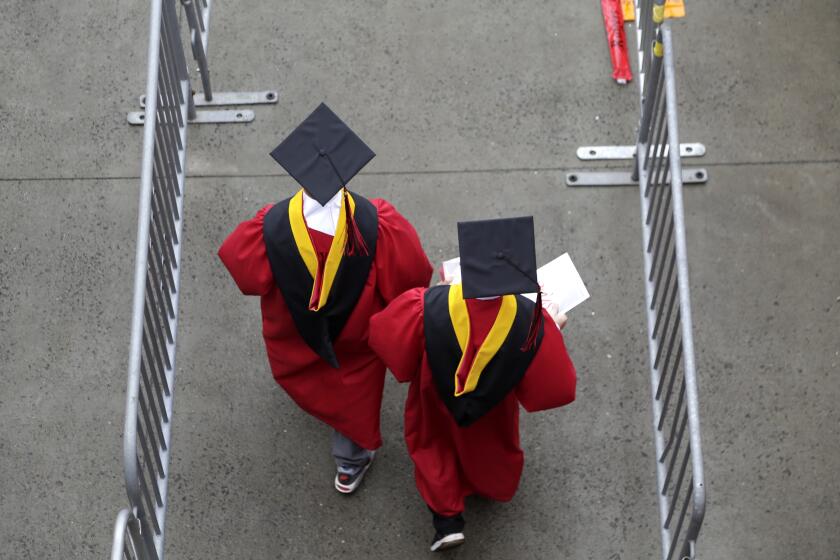Opinion: Can California fix the disconnect between public education and the modern workforce?

If Democrats want to change their fortunes in future national elections, acknowledging that our public education system is disconnected from the modern workforce would be a good place to start. President-elect Donald Trump won 56% of voters without college degrees, a reversal of historical trends in which Democrats have been the clear choice of the working class. Those who choose not to attend, or cannot afford, four-year universities have fewer opportunities.
To win back working-class voters, Democrats must reimagine public education, shifting the one-size-fits-all approach we have now to a dynamic workforce model that prepares young people for high-wage jobs and membership in a prosperous middle class — whether or not they attend college.
The Democratic Party’s economic focus has been on job creation, child tax credits and other assistance. That’s great — but those efforts usually aren’t seen by young voters. When critics claim we have become the party of elites, they may mean we have come to define success, especially for young people, as an unsatisfactory binary choice. Either you go to college and gain the traditional higher education degree, or there just isn’t much out there for you.
The young people I talked with feel either ignored or preached at by those in today’s political system. What they want is to be taken seriously — and to be inspired.
But when part of the reason for teenagers’ struggles in school is that they cannot see how the subjects they take connect to what they might do for work, seeds of discontent are planted. Young people also know that our public school system is not set up so that those who educate them and those who hire them are working together on students’ behalf. The frustrated 16-year-olds of today are tomorrow’s swing voters.
Broad reform of public education, that moves beyond arguments about charter schools or adding a few vocational courses, is necessary to provide equal opportunities for young people. It’s also an important component of any strategy to rebuild an invigorated Democratic coalition.
I loved my Los Angeles teaching job. But caring for a special needs child made navigating the long, inflexible hours nearly impossible.
It’s not just about bringing back auto and wood shop. We must design and teach core academic subjects in ways that are relevant and connected to high-growth job sectors. For those interested in criminal justice careers, some high-level science can be taught around analyzing DNA. Math and science can be taught around nutrition and agriculture, benefiting students who might pursue work in culinary or hospitality sectors.
Our country’s education standards should require that every academic subject have multiple ways to teach it, tied to career pathways. Each should be rigorous and relevant enough for students to be able to choose either college or apprenticeship with a program or employer that helps prepare them for a good job in their chosen profession. High schools should also have centers that can help facilitate paid internships or jobs for students in a variety of careers.
The U.S. is behind many other advanced countries in preparing young people for the workforce if they do not attend college. In Switzerland, for example, more than half of all 16-year-olds have year-round paid work experiences in fields including banking and construction. Industries work with public educators to develop courses that meet high academic standards and prepare students for careers in various specialties.
There are valid alternatives to getting a four-year degree, but for the U.S. to thrive and for students to be all they can be, the emphasis on college should remain.
California is on this path. Last year, Gov. Gavin Newsom ordered state agencies to reduce barriers to employment, including prerequisite bachelor’s degrees, for most state jobs. It’s one of at least 10 other states moving in this direction and applying skill-based criteria for their state workforces.
Since 2015 California has invested over $3 billion in providing career pathways in public high schools. As of last year, 23% of students in schools with these programs were participating in some career track, up from 18% from six years ago.
Some of the opportunities our state’s high schools provide include preparing for agriculture careers on a 20-acre farm in Madera County, logistics and maritime instruction along the ports of Los Angeles and Long Beach, and tracks in media and film in Southern California.
But there’s much more to do. Three-quarters of California high school students have no career pathway programs and the ones that do exist need to be brought to scale. Most core academic courses are still taught out of standard textbooks. State standards must change to require creative ways of teaching these subjects that better prepare students for life after high school.
California’s efforts can be an example for other states — and for Democrats. As our state continues to expand its program, the party can look to what it has already developed to set their national education and workforce agenda. The opportunity is huge, if Democrats choose to grasp it.
I hope our party goes on offense, learns from its mistakes and resists the inevitable injustices that Trump will attempt. But I also hope, as Democrats look to redefine themselves to voters, that we don’t limit ourselves to tactical adjustments or repackaging old ideas. Focusing on the education and economic well-being of the working class benefits the party as a sound political move, and it’s also the right thing to do because it will give more Americans the opportunities they deserve.
Darrell Steinberg is the outgoing mayor of Sacramento, former president pro tem of the California Senate and author of the 2013 California Career Pathways Trust, the state’s initial $500-million investment in career technical education.
More to Read
A cure for the common opinion
Get thought-provoking perspectives with our weekly newsletter.
You may occasionally receive promotional content from the Los Angeles Times.













